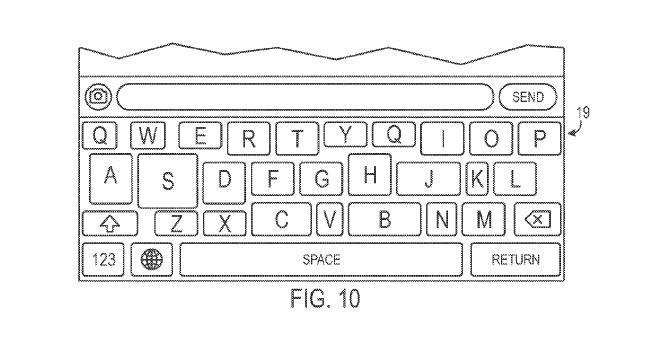A patent application revealed on Thursday shows that Apple may be working on improving the accuracy of the touchscreen keyboards featured in its iDevices by allowing them to automatically adjust aspects such as key sizes to user typing behavior on the fly.
U.S. Patent Application No. 13/213,173 describes a "Touch Correcting Keypad," largely similar to the current software keyboard found in iOS. The keypad found in the application, though, has a "Typo-Adaptable Keyboard" setting, allowing it to modify the shapes of and space between keys in order to compensate for user typing patterns. The application notes that the software keyboard could alter either the visual representation of the keys or the input regions the device recognizes.
Multiple drawings throughout the patent application demonstrate the concept in action. One shows the 'Shift' key increasing in size, along with reductions in size for the 'A' and Q' keys. Another shows the space between the 'A' and 'Q' keys increasing, and yet another shows the 'S' key reshaping itself considerably, while the 'W' key decreases. Figure 10 in the application shows the familiar QWERTY keyboard, but with its keys dramatically resized.
Were the patent to make its way into an actual iOS release, it could help to address some users' complaints about typing on Apple's increasingly popular mobile devices. The company made waves in introducing the original iPhone, which eschewed a physical keyboard in favor of a touchscreen-based QWERTY layout.
Apple compensated for the lack of keys by integrating predictive text input into its iOS software keyboard. But some still feel the lack of tactile feedback on touchscreens can still hamper the production of text-intensive content.
Apple is not alone in moving to improve the quality of its touchscreen keyboard. BlackBerry, in announcing its new Z10, went to great lengths to demonstrate its touchscreen keyboard's ability to accept text input as quickly and accurately as the company's famed physical QWERTY keyboards. Google also recently added a Swype-like text entry method to its standard Android keyboard.
 Kevin Bostic
Kevin Bostic









 Malcolm Owen
Malcolm Owen
 Amber Neely
Amber Neely

 Wesley Hilliard
Wesley Hilliard


 William Gallagher
William Gallagher









26 Comments
So in a txt msgng wrld. The vwls would b tny?
As I understand it, this is already implemented. Just not visible. Oh we'll, looks a bit odd though, but I need to try it out to give it an honest opinion. Auto correct is a bit hit or miss, but then I'm not a regular user because I type bilingual quite often.
PhilBoogie,
Why not use the international settings to swap between multiple keyboards? It adds a "globe" key to the keyboard to switch, so it's really fast. I'm a bilingual user too and I find it great. Especially for automatically adding accents :)
PhilBoogie,
Why not use the international settings to swap between multiple keyboards? It adds a "globe" key to the keyboard to switch, so it's really fast. I'm a bilingual user too and I find it great. Especially for automatically adding accents :)
It works great indeed, but the question is "how does the autolearning adapt to multiple keyboards active" :D
It would be more useful to just give the user more control over the keyboard itself and to modify it's default behaviour. I find it hard to understand why after five years we still have no control even over simple stuff like first letter capitalisation of sentences, or the ability to pick a different arrangement of letters etc.